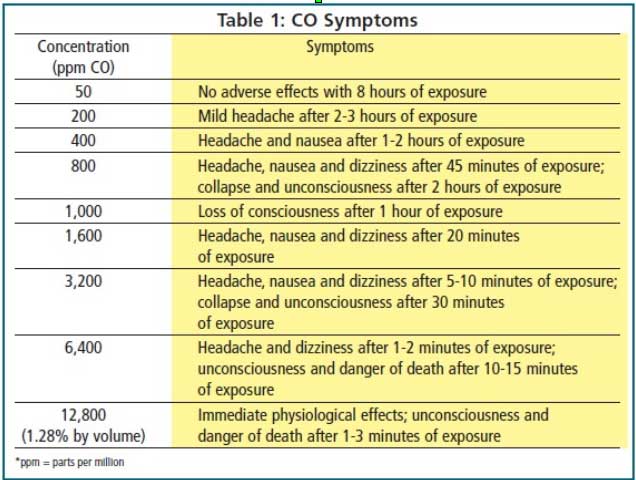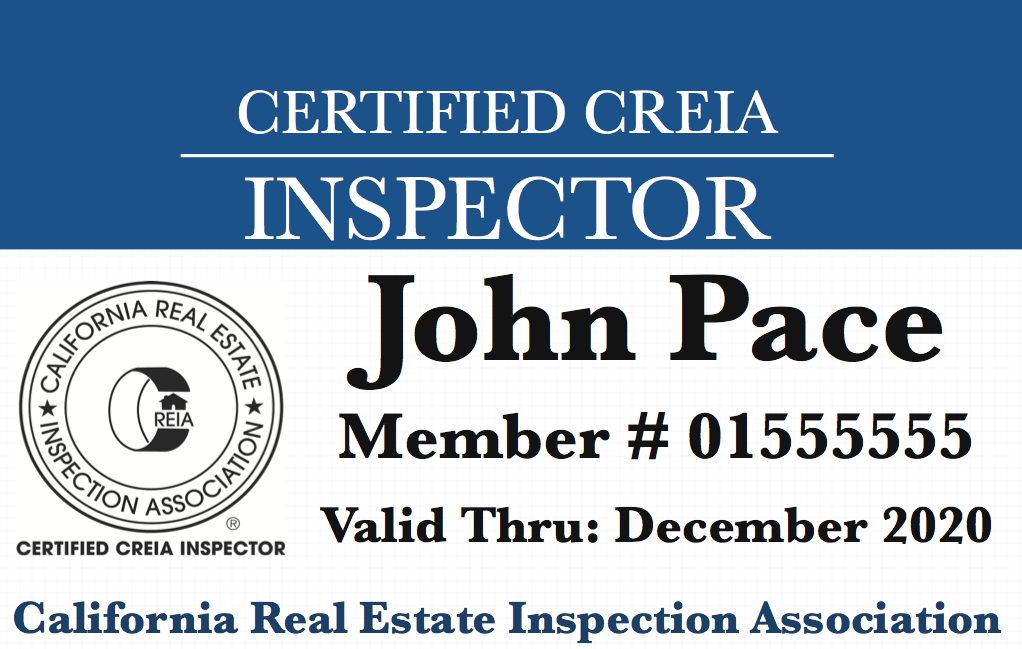Carbon Monoxide - Leading Cause of Poisoning DeathsBy Skip Walker, MCI ACI July 2011 Depending on who's statistics you believe, carbon monoxide poisoning causes between 200 and 700 deaths per year in the US. For every person killed there are another 5 or so that will require some form of hospital visit. No matter which numbers you use, this makes carbon monoxide the leading cause of poisoning death in the US. There are studies that indicate that the actual number of deaths may be significantly higher. The symptoms of carbon monoxide poisoning present as flu-like symptoms without a fever. This makes it easy to misdiagnose. Only about 1 case in 10 appear to actually be diagnosed at all. Even worse, only 1 in 77 will be properly diagnosed based on symptoms alone. A British study gave 200 general practitioner (GP) doctors a hypothetical set of symptoms for a CO poisoning case. None of the doctors gave CO poisoning as a potential cause. CO poisoning is more often misdiagnosed as flu, viral infections, depression, psychosomatic illness, Parkinson's, Crohn's disease, asthma, Chronic Fatigue Syndrome (CFS). Often no diagnoses is made at all. Over 60% of the time, CO poisoning is discovered only when someone collapses. CO poisoning is discovered during some sort of equipment repair service in only around 30-40% of the cases. Routine service calls for cleaning/adjustment, etc. will uncover CO poisoning issues in less than 10% of the cases. Carbon monoxide is odorless and colorless. It acts on the body because the CO molecule easily binds itself to the oxygen in the bloodstream. This renders to oxygen incapable of transferring itself to the body. CO poisoning is literally asphyxiation from the inside out. CO poisoning is cumulative. The effect CO has on the body is a function of both concentration and time. A low level of exposure for a long period of time can be just as dangerous as a high concentration for a short period. It is commonly believed that effects are short-lived and will disappear if the victim is given fresh air or oxygen. This may not always be true. There appear to be a number of long-term issues and even some permanent damage caused by low level exposure over long periods of time.
Statistically, women are almost twice as likely to be affected by CO poisoning, presumably because they are more likely to be at home with children. The highest risk groups tend to be children/fetuses, the elderly and those with impaired respiratory function. In my area, an elderly man recently died when his liver shutdown apparently from very long-term exposure to very low levels of CO. The living space was believed to have had 10-15 PPM CO concentrations for a very long period of time – in this case several years. These levels are generally not considered a risk for most of the population and are far below the minimum detection level found in UL approved residential CO alarms. As with many other issues, individual responses to CO will vary widely. A CO molecule has about the same density as air, so it generally mixes readily with air. However, in residential situations, CO is often introduced into the dwelling by car exhaust, gas appliances back-drafting, unvented appliances, etc. All of those streams are warm by nature. Consequently, the CO is - at least initially - carried higher in the living space. Because of this, some feel that better early detection may be achieved with sensing devices that are placed higher in the living space. Carbon monoxide is a byproduct of incomplete combustion. It can result from a number of issues in fuel burning appliances. Improper adjustment or maintenance, flame impingement are just a few of the causes. Appliances can easily discharge CO into the living space when the vent system is obstructed or improperly designed or installed. When gas appliances are located inside the living space other systems can impact drafting. Clothes dryers, bath exhaust fans, kitchen exhaust fans, etc. all draw significant amounts of air out of the dwelling. This can create a negative air pressure condition inside the dwelling that will draw air from the outside through all available openings – such as appliance vents. If a forced air furnace return air system is improperly sealed, it can create a negative air pressure condition in the furnace enclosure. This can result in the appliance back-drafting and entraining combustion byproducts into the living area. External air movement can also generate negative interior air pressure conditions. Car exhaust is another big contributor as well. An car produces significant amounts of CO when cold idling. Even with the vehicle door open, measurable amounts of CO can be drawn into the dwelling due to negative pressure conditions. Prevention of CO issues is critical. The proper inspection of gas appliances, including the vent system, operational issues, etc. is the single most important area where a general property inspector can provide important assistance. Unfortunately, routine inspections by HVAC contractors and local gas providers have been shown to be inadequate. Less than 10% of CO poisoning cases are detected through routine inspections. Awareness is a critical aspect in this. The public, the medical community and fuel-burning appliance professionals all need to be aware of the issues and the symptoms. Detection is the other critical aspect. The new California Carbon Monoxide Poisoning Prevention Act of 2010 is certainly a step in the right direction. However, as with smoke alarms, there are different types of CO alarms and even within types, the units vary widely in actual effectiveness. The type of CO sensor used in most most residential alarms today is an electrochemical type. These sensors have a useful life of approximately 5 to 10 years. Most manufacturers recommend that electrochemical-based CO alarms be replaced every 5-7 years. Other types may only last 2-3 years. The response and recovery times for different sensor types varies widely as well. Proper wording when we report is important. The UL 2034 standard covers CO alarms. An alarm has a built-in annunciator/audible alarm. A detector is a sensor only connected to a remote control/alarm system. This is the same as a smoke alarm versus a smoke detector. A CO alarm certified under the UL 2034 standard should respond under the following basic set of conditions: At 30 parts per million: Unit must sound alarm within 30 days At 70 parts per million: Unit must sound alarm within 60-240 minutes At 150 parts per million: Unit must sound alarm within 10-50 minutes At 400 parts per million: Unit must sound alarm within 4-15 minutes A number of studies, including ones by the Gas Research Institute, Consumer Product Safety Commission, a British field study and UL themselves have found significant issues with the current generation retail CO detectors. These studies show no significant improvement in CO alarm performance between the current UL 2034 (effective 1998) standard and the previous version of the standard. These studies show that around 4% of units will false alarm to fresh air out of the box, especially in high humidity conditions. In 7 of 10 commercially available brands, a significant number failed to respond to hazardous levels of CO. Of the 7 of 10 commercially available brands tested, around 37% failed to respond to the levels in the UL certification test. Of the 6 worst performing brands, almost 80% failed to respond in very low humidity conditions, the same units failed to respond nearly 50% of the time to moderate humidity. Digital displays were also tested and found to be very inaccurate varying by plus/minus 30%. In one brand, the display consistently read 0 PPM when exposed to 100 PPM levels. This particular study was a blind test, so the brand names were not released. Almost all brands showed a measurable loss in sensitivity over time. The current UL 2034 standard is a design standard. It does not address the alarm performance over time or variances due to manufacturing. Many of the brands tested responded to fixed concentrations of CO as defined in the UL test, but failed to properly integrate rising CO levels and properly alarm. This type of alarm may not fully protect occupants in a situation where CO levels became progressively worse over time. The GRI and CPSC tests both concluded that the current UL 2034 test should be altered to include a requirement for reliability, both at the manufacturing stage and for longevity. These recommendations have been integrated into the Canadian Standards Association (CSA) test for CO alarms. The dangers of CO poisoning are very real. Yet the science of detection is in the early stages. Detection is simply not reliable enough yet to allow anyone to rely solely on it for the safety of their families. It is clear that routine inspections are inadequate as well. The medical community seems unaware of the full extent of the issues. Where does this leave us as property inspectors? We are one of the primary gatekeepers of public safety. We are the ones finding the disconnected gas vents in the attics and crawlspaces. The ones finding the back-drafting water heater in the laundry room. More often than not, we are the only ones in the process that are really looking out for the safety of the occupants. I am not sure about you, but I consider it a great day when I go home knowing that I probably saved lives at that last inspection. About the author: Skip Walker lives in the SF Bay Area and has performed nearly 3,000 property inspections since 2003. Skip is a Master CREIA Inspector (MCI), an ASHI Certified Inspector (ACI), an ICC Certified Residential Combination Building Inspector and a F.I.R.E. Certified Inspector. Skip is the past education chair for the Silicon Valley ASHI/CREIA Chapter, CREIA 2010-2011 State Secretary, CREIA Region Three Director 2009-Current and was named CREIA Inspector of the Year 2011. He also holds a California Real Estate Appraisal Trainee License. Skip may be reached at (650) 873-4224 or by email at: [email protected]. |



